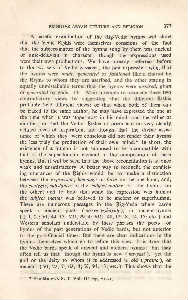Page 596 - Lokmanya Tilak Samagra (khand 2)
P. 596
PRIMITIVE ARYAN CULTURE AND RELIGION 377
A careful examination of the ~ig-Vedic hymns will show
that the Vedic ~ishis were themselves conscious of the fact
that the subject-m~tter of the hymns sung by them was ancient
or ante-deluvian. in character, though the expressions used
were their own productions. We have already referred before
to the two sets of Vedic passages, the first expressly saying that
the hymns were made, generated or fashioned like a chariot by
the ~ ~his to whom they are ascribed, and the other stating in
equally unmistakable terms that the hymns were inspired, given
or generated by gods. Dr. Muir attempts to reconcile these two
contradictory view by sugge ting that the different }3.i~his
probably held different views; or that when both of them can
be traced to the same author, he may have expressed the one at
the time when it was uppermost in his mind, and the other at
another; or that the Vedic ~i~his or poets had no very clearly
defined ideas of inspiration, and thought that the divine assis-
tance of which they were conscious did not render their hymns
the less truly the production of their own mind.* In short, the
existence of a human is not supposed to be incompatible with
that of the super-human element in the composition of these
hymns. But it will be seen that the above reconciliation is at once
weak and unsatisfactory. A better way to reconcile the conflict-
ing utterances of the ~i~his would be to make a distinction
between the expression, language or form on the one hand, and,
the contents, substance or the subject-matter of the hymns on
the other; and to hold that while the expression was human
the subject matter was believed to be ancient or superhuman.
There are numerous passages in the ~ig-Veda where bards
speak of ancient poets ( pilrve r(~haya~ ), or ancient hymns
(I, 1, 2,; VI, 44, 13; VII, 29, 4; VIII, 40, 12; X, 14, 15; etc.) and
Western scholars understand by these phrases the poets or
hymns of the past generations of Vedic bards, but not anterior
to the post-Glacial times. But there are clear indications in the
hymns themselves which go to refute this view. It is true that
the Vedic bards speak of ancient and modern hymn ; but they
often tell us that though the hymn is new ( navyas£ ), yet the
god or the deity to whom it is addressed is old ( pratna ), or
ancient, (VI, 22, 7; 62, 4; X, 91, 13; etc.). This shows that the
\
• See Muir 0. S. T. Vol. III, pp. 274-5.

